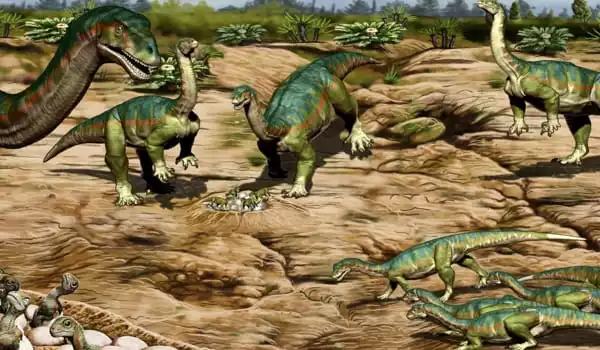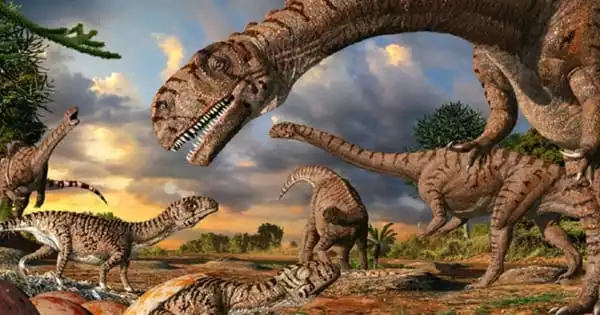Scientists believe they have discovered the first evidence of complex herd behavior in dinosaurs. Researchers believe Mussaurus patagonicus lived in herds around 193 million years ago, which is 40 million years earlier than previous evidence of dinosaur herding. To paraphrase a line from the film “Jurassic Park,” Dinosaurs do travel in groups. And, according to a new study, the prehistoric creatures lived in herds much earlier than previously thought.
Researchers from MIT, Argentina, and South Africa detail their discovery of an exceptionally preserved group of early dinosaurs that show signs of complex herd behavior as early as 193 million years ago, 40 million years earlier than other dinosaur herding records. Since 2013, team members have excavated more than 100 dinosaur eggs (about the size of chicken eggs) as well as the partial skeletons of 80 juvenile and adult dinosaurs from a rich fossil bed in southern Patagonia.
They were able to examine the contents of the eggs without breaking them apart, and discovered preserved embryos within, which they used to confirm that the fossils were all members of Mussaurus patagonicus – a plant-eating dinosaur that lived in the early Jurassic period and is classified as a sauropodomorph, a forerunner of the massive, long-necked sauropods that later roamed the Earth.
Surprisingly, the researchers discovered that the fossils were grouped by age: dinosaur eggs and hatchlings were found in one area, while juvenile skeletons were found in another. Meanwhile, adult dinosaur remains were discovered alone or in pairs throughout the field site.
We’ve now observed and documented the earliest social behavior in dinosaurs. This begs the question of whether living in a herd played a significant role in dinosaurs’ early evolutionary success. This provides some insight into how dinosaurs evolved.
Jahandar Ramezani
The researchers believe that this “age segregation” is a strong indicator of a complex, herd-like social structure. The dinosaurs most likely worked as a group, laying their eggs in a communal nesting area. Adults roamed and foraged for the herd, while juveniles congregated in “schools.”
“This could indicate that the children were not following their parents in a small family structure,” says team member Jahandar Ramezani, an Earth, Atmospheric, and Planetary Sciences research scientist at MIT. “There is a larger community structure, where adults shared and contributed to the upbringing of the entire community.”
Ramezani used ancient sediments found among the fossils to determine that the dinosaur herd lived around 193 million years ago, during the early Jurassic period. The findings represent the first evidence of social herding among dinosaurs.
Living in herds may have provided an evolutionary advantage to Mussaurus and other social sauropodomorphs. These early dinosaurs appeared in the late Triassic period, just before a mass extinction event that wiped out many other animals. Sauropodomorphs survived and eventually dominated the terrestrial ecosystem in the early Jurassic.
“We’ve now observed and documented the earliest social behavior in dinosaurs,” says Ramezani. “This begs the question of whether living in a herd played a significant role in dinosaurs’ early evolutionary success. This provides some insight into how dinosaurs evolved.”

A fossil flood
The team’s paleontologists have been working in the Laguna Colorada Formation, a site in southern Patagonia known for containing early sauropodomorph fossils, since 2013. When scientists discovered fossils within this formation in the 1970s, they named them Mussaurus, which means “mouse lizard,” because they assumed the skeletons belonged to miniature dinosaurs.
Scientists, including members of the Argentinian team, discovered larger skeletons much later, indicating Mussaurus adults were much larger than their rodent namesakes. However, the name stuck, and the team has continued to unearth a diverse collection of Mussaurus fossils from a small, square kilometer of the formation.
The fossils discovered so far have been found in three sedimentary layers that are close together, implying that the region was a common breeding ground to which the dinosaurs returned on a regular basis, possibly to take advantage of favorable seasonal conditions.
Among the fossils discovered was a group of 11 articulated juvenile skeletons that were intertwined and overlapping each other, as if they had been thrown together at random. In fact, based on the exceptional preservation of the entire collection, the team believes this particular herd of Mussaurus died “synchronously,” perhaps quickly buried by sediments.
The Laguna Colorada Formation has long been assumed to be relatively young on the dinosaur timescale based on evidence of ancient flora in nearby outcrops. Could these dinosaurs have been herding from the beginning?
“People already knew that the large herbivore dinosaurs exhibited social behavior in the late Jurassic and Cretaceous periods — they lived in herds and had nesting sites,” Ramezani says. “But the question has always been, when did such herding behavior first appear?”
A gregarious line
To find out, Diego Pol, a paleontologist at Argentina’s Egidio Feruglio Paleontological Museum who led the study, looked for volcanic ash samples among the fossils to send to Ramezani’s lab at MIT. Volcanic ash can contain zircon, which is a mineral grain containing uranium and lead, and whose isotopic ratios Ramezani can precisely measure. He can calculate the age of the zircon and the ash in which it was discovered using uranium’s half-life, or the time it takes for half of the element to decay into lead. Ramezani identified zircons in two ash samples, all of which he dated to around 193 million years ago.
Ramezani’s analyses strongly suggest that the dinosaurs were buried at the same time the volcanic ash was deposited because the ash was discovered in the same sediment layers as the fossils. A flash flood or windblown dust may have buried the herd, while ash from a distant eruption happened to drift over and, luckily for science, deposit zircons in the sediments. The findings show that Mussaurus and possibly other dinosaurs evolved to live in complex social herds as early as 193 million years ago, near the beginning of the Jurassic period.
Scientists believe that two other types of early dinosaurs, Massospondylus from South Africa and Lufengosaurus from China, lived in herds around the same time, though dating for these dinosaurs has been less precise. If multiple separate lines of dinosaurs lived in herds, the researchers believe social behavior evolved earlier, possibly as far back as their common ancestor in the late Triassic.
“We now know herding existed 193 million years ago,” Ramezani says. “This is the first time that gregarious behavior in dinosaurs has been confirmed. However, paleontologists believe that if social behavior is found in this type of dinosaur at this time, it must have evolved earlier.”





